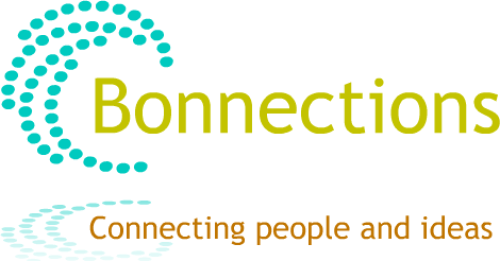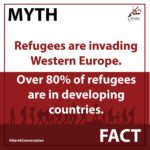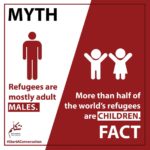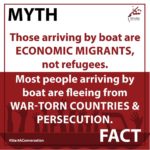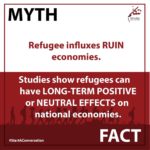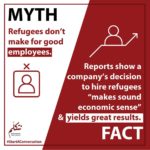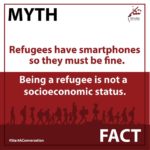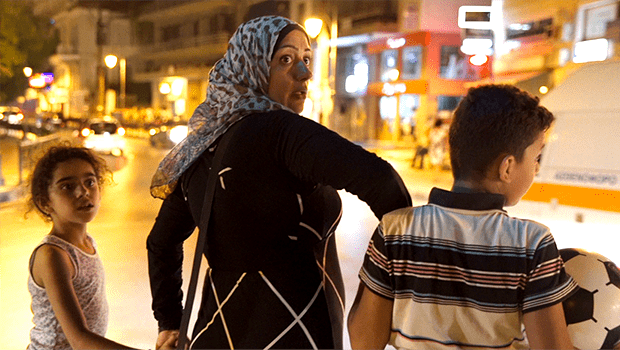
“I am deeply concerned to see more and more situations where refugees are not receiving the protection they need and to which they are entitled,” says UN Secretary General António Guterres in his 2018 World Refugee Day message . “In today’s world, no community or country providing safe refuge to people fleeing war or persecution should be alone and unsupported. We stand together, or we fail.”
The United Nations are currently working on a new deal for refugees, which is expected to be adopted by the UN General Assembly towards the end of 2018. The global compact on refugees seeks to improve the international response to refugee situations and to ensure that refugees and the people hosting them receive the support they need. Another aim is to help refugees become more self-reliant, so that they can contribute more to their own future and to that of the host community.
Because shedding light on myths and relevant facts is key to creating more welcoming societies, NaTakallam (“we speak” in Arabic) launched this month an awareness campaign related to global displacement.
NaTakallam is a New York based social impact start-up that pairs Arabic-speaking displaced persons with Arabic learners around the world for language practice over Skype and other digital communication tools. The platform offers affordable, flexible, tailored Arabic practice while providing a valuable income source to displaced people. The language instructors mostly live in Lebanon, but also in Turkey, Iraq, Egypt, France, Brazil, Italy and Germany. Since starting in 2015, NaTakallam has paired more than 100 displaced persons and 2500 indivituals in more than 65 countries. Displaced people have self-generated over $300,000 through their work with NaTakallam.
Study center launched to enable digital integration of refugees in Bonn
A new study center opened this Monday at the Tannenbusch House in Bonn to give refugees and newcomers access to such income generating opportunities, entrepreneurial training and digital education, like Kiron Open Higher Education , Redi School of Digital Integration or the Goethe Institute’s Deutsch für Dich online community. Initiated by Bonnections, the digital study center provides free access to the Internet and Chromebooks obtained through the Re:Connect project of Nethope and Google.org.
Matching refugees with job opportunites and training programs is made possible by modern data technology. NaTakallam helps Arabic speaking refugees earn extra income, but it is not a solution for the lack of employment and integration of new arrivals into the European labor market . This requires coordination and innovation across governments and the private sector alike: Newcomers often lack information about job opportunties, while employers are often unaware of their potential. In Germany, volunteers have set up the online platform Workeer to match refugees to jobs.
To start working, refugees and asylum seekers need three things: the right to work, appropriate skills and job opportunities. The StepUp report and policy roadmap, recently published by the Tent Foundation, sets out to accelerate refugee employment. While resettled refugees have the right to work immediately, those who claim asylum on arrival in the country in which they are seeking protection typically do not.
Such is the backlog of asylum cases in many European countries and the United States that many asylum seekers are left in limbo for a lengthy period, allowing their skills to rust, depressing their motivation and deterring future employers. According the report, there is also a strong business case for hiring refugees. They are typically hard-working and highly motivated, and a more diverse workforce tends to boost creativity and innovation and can help tap new markets both domestically and abroad.
Number of globally displaced people the highest ever been
In its annual Global Trends report, released yesterday, the UN Refugee Agency (UNCHR) said 16.2 million people became displaced during 2017, either for the first time or repeatedly. Refugees who have fled their countries to escape conflict and persecution accounted for 25.4 million of the total 68.5 million displaced pleople. This is 2.9 million more than in 2016, also the biggest increase UNHCR has seen in a single year.
“We are at a watershed, where success in managing forced displacement globally requires a new and far more comprehensive approach so that countries and communities aren’t left dealing with this alone,” said UN High Commissioner for Refugees Filippo Grandi.
The UNCHR report offers several insights into perceived versus actual realities of forced displacement. Among these is the notion that the world’s displaced are mainly in countries of the Global North. The data shows the opposite to be true – with fully 85 per cent of refugees in developing countries. Four out of five refugees remain in countries next door to their own. Two other insights are that most refugees live in urban areas (58 per cent) not in camps or rural areas; and that the global displaced population is young – 53 per cent are children.
Seven years of fighting in Syria have driven 6.1 million people from their homes inside Syria, and forced 5.6 million refugees to seek safety in neighbouring countries. According to UNHRC, the vast majority of Syrians in exile live below the poverty line. More than three quarters of refugees in urban areas of Jordan and Lebanon are unable to meet their basic food, shelter, health or education needs. Though the percentage of refugee children in school has increased in recent years, 43 per cent of the 1.7 million school-aged Syrian refugees are still out of school.
Cutting through fear and misinformation
In 2015, we witnessed an unprecedented wave of migration to Europe, with over one million refugees crossing the Mediterranean.
